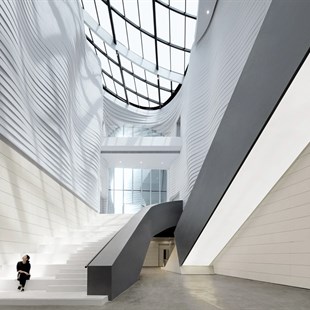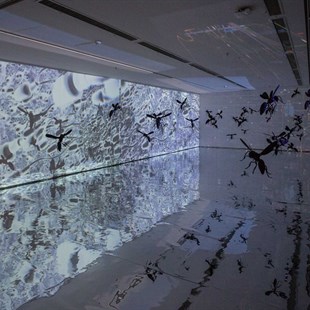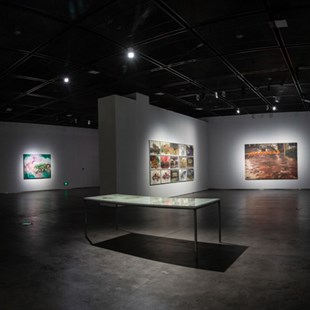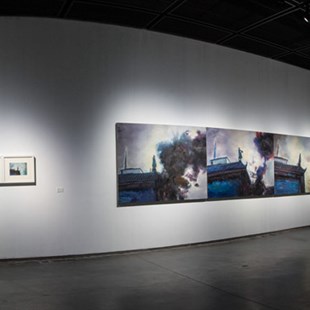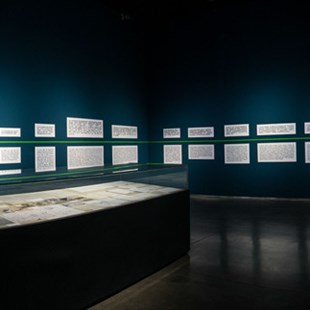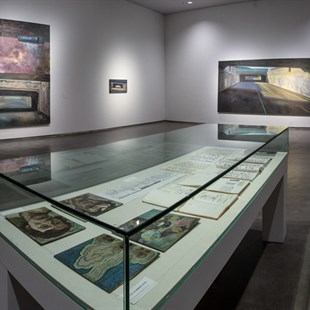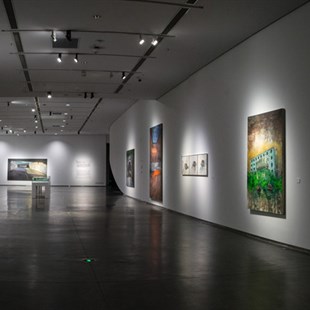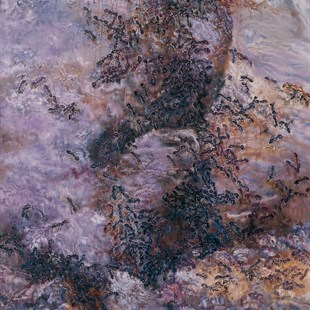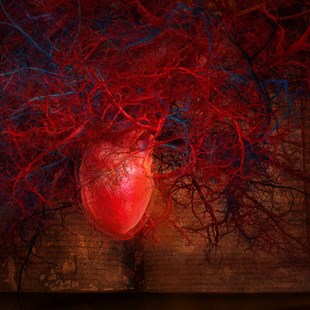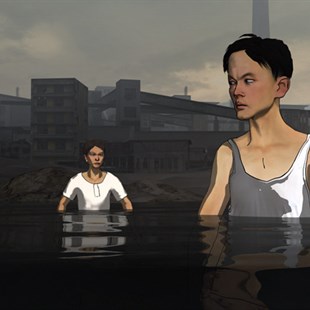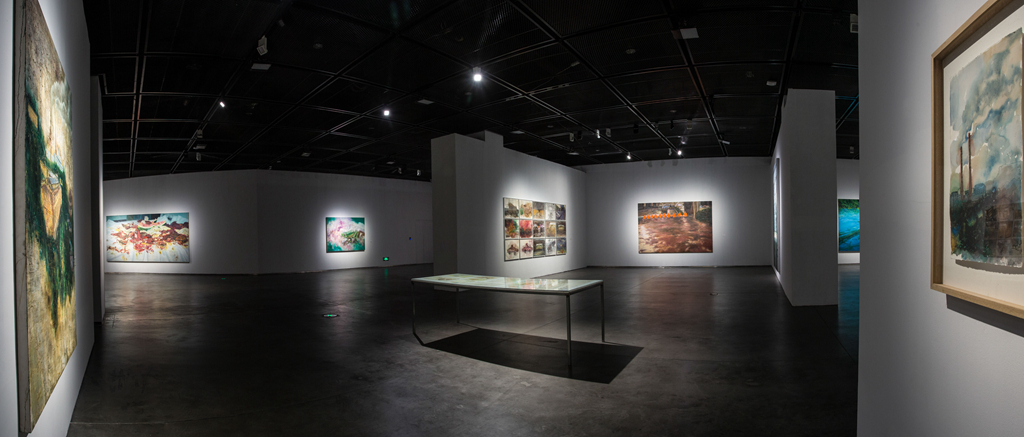
Meeting theology in the secular world,
Showing the truth hidden in pores and cracks…
Search for truth in uninhabited cellars and attics. 1
—Sigfried Kracauer
Everything around us seems to be digitized. In an era with rapid developments, “0” and “1” are two extremely simple numbers. They not only constitute the images we see today, but they also weave all related words into this large invisible network. During globalization, communication, beliefs, disputes, consumption, enjoyment… people are involved in the vortex of relations, complex and multidirectional structures frame the basic appearance of life. Observing society and understanding people may also give us a glimpse of what some artists are doing.
“Seeing the big from the small” is the narrative skill of artist Zhang Xiaotao. In other words, no matter how his creative methods are updated, from the creation of oil paintings in the early years to his new media works, animations and installations in recent years, it is not difficult to find that “macro and micro” surround the basic contradictions in his works: DNA, cells, ants, factories, urban systems, memories, history, dreams, imagination, living beings, all things on earth, and the universe, he records and edits the elements whether “small” or “big”, like the “0” and “1” in the codes, and he arranges different transformation laws, draws a connection point between reality and fiction.
So, how has he found this hidden “microscopic” clue, thus forming a highly artistic expression, to connect, reconstruct, tell, and explore in his own individualistic way?
Zhang Xiaotao was born in Chongqing in 1970. He graduated from the Oil Painting Department of the Sichuan Fine Arts Institute in 1996. He co-founded the New Media Department of Sichuan Fine Arts Institute in 2010. He served as the Head of the Department from 2010 to 2015. He is an associate professor and Master’s Degree supervisor. Supervised by Xu Bing, he graduated with a Ph.D. degree from China Central Academy of Fine Arts in 2016. Zhang Xiaotao is currently a representative of new media arts in China who is active internationally and locally. His important exhibitions include the 55th Venice Biennale (2013), the 7th Asia Pacific Triennial of Contemporary Art, Linz Electronic Arts Festival in Austria, Dutch Animation Film festival and so on.
His latest solo exhibition “Microscopic Event” was held at MOCA Yinchuan, and Lv Peng served as the curator. This exhibition presents paintings, animations, videos, installations, related literature, interview reports which is by far the most comprehensive art exhibition for Zhang.
Rotten Desires, the Irony of Consumption
Affected by scar art in the 1970s and 1980s, the artists of that era are completely different from the artists who grew up in the 1980s and 1990s. History, traces and realistic issues are all infused into the blood and they are used to shoulder the collective will. Choosing a perspective from a grand level, Zhang Xiaotao instead intends to break away from the paradigm. His works have traces of memory as well as realistic criticism. He strives to accept new life and things, and pays more attention to the heart, the process, and thinking caused by descriptive objects.
Zhang Xiaotao went to live in Beijing in early 2000. The creations of this period came out of his daily life perceptions, not just a record. A similar sensitivity can also be read from his Memoirs (2002), “Heaven (210×400cm), 310 Room, 116 Building (210×400cm) conveyed a new life in Beijing as I understood it. They were full of youthful hedonism and emotions of eschatology. The mirror image of the excessively erosive erosion is dizzy, full of fear, restless … Sometimes I feel like dust, an ant, a dead rat, a pile of moldy, stinky trash…our rotten life, rot and splendor, sometimes rot is splendid.” 2
The use of a large number of symbolic images constitutes the basic symbols of art. The main “object” in the picture is very direct: the fiery red crayfish residue on the oil-soaked plastic tablecloth, the watermelon left after half a bite, the huge cake that collapsed, and the moldy strawberry covered with green fungus. Most of the pictures are focused and promoted with the sense of a lens and large-scale pictures dominate. The first reaction that might occur to viewers is to repel them, not only because they are only a few steps away to observe the comprehensive picture, but also because they seem to be full of weird “flavors”. The seemingly extravagant illusions are scattered, signals from the erosive smell are sent out and organs in the whole body are mobilized. Thinking about it, is the trash we reject the residue of daily self-consumption constituting the real world we take for granted?
“Mice, rotten strawberries, crumbling cakes, and ants” and so on refer directly to anxiety and a reflection on the materialized society, desire, survival relationship, and the impact of globalization. In this materialistic society, he borrowed tiny, inconspicuous, surviving things to express resistance and scream out, “I hope to express these microscopic fragments in the fear of survival, smallness, pressure, and erosion through my works. They are the enlarged sampling of our absurd and indulgent fragments of material life, which is also our instinctive doubts and reactions to this materialized desiring society.” 3
After in-depth practice, the screen symbols have been expanded to include medical waste, heavy steel trucks, urban subways and internet images. From the perspective of “social morbidity”, he tried to dig out contradictions in the social landscape and seek the root cause of the disease. These meaningful elements have been reconstructed to reveal complex phenomena, and these phenomena have been transformed into another way to infiltrate our lives. Compared to 15 years ago, currently people may be more unable to escape from the conveniences brought by consumerism, material pursuits, desires, fantasies, decay and perplexity that overlap and recycle in the visible and invisible places endlessly.
Dynamic Narrative: From 2D Painting to 3D Video
Being unsatisfied with an art form, Zhang Xiaotao also carried out experiments in the fields of painting, video, installation, and comprehensive art. The topics he is concerned with are no longer confined to personal life, and are gradually put into the wider social reality, crowds, and events, but he has never been removed from the experimental nature of “micro and macro”.
Compared with the two-dimensional paintings, the three-dimensional animation is more dynamic. At the end of 2005, Zhang Xiaotao completed his first animated work Night. He was very excited with this first animation. At the same time, he was preparing for the creation of another Mist (2008). The words of his work suggested some information on confusion and elusiveness. In this film, he used micro-narrative sampling to zoom in. He used scenes from Chongqing Steel Mill, Tibet, Shenzhen and other places to connect, deconstruct and analyze personal experience with social history and urban life. What he saw in Chongqing’s old Steel Mill, life experience in Beijing 798 Art District and quotes from the development plans of the emerging city of Shenzhen, the three clues overlap and change. Memory, home, belief, history, change, time and space in the same scene, everything seems to be so familiar, but everything is like a dream, new in a plausible visual maze.
A series of films, short films, and animations created by Zhang Xiaotao have continued his creative DNA, starting from his personal memory, drawing from reality, weaving multiple topics, reconstructing visual methods and inspiring reflections. For example, his work Sakya (2011) participated in the 55th Venice Biennale and it comes from the artist’s childhood experience of being influenced by Buddhism and the impression of visiting Dunhuang. Reality and illusory, shuttled through dynamic fragments, while digging into the topics of religion, society and history; The Adventures of Liang Liang (2013) uses the original manuscript of his son as the concept and origin, opening up a new mode of dialogue, full of fantasy, longing for innocence, and the collision of rational logical thinking, the adults’ world meets the children’s world which has produced a wonderful effect.
The animated documentary The Spring of Huangjueping (2011-2016) is based on the “urban-rural junction” of Huangjueping, with the experience of Zhang Xiaotao taking the college entrance examination and the living experience in Chongqing as the background, interspersed with magic and realistic scenes, reflecting the aspirations of a generation. At the beginning, he was confused by youth and he asked the question, “This is an era where personal experience and collective experience are entangled. Are we all exiling ourselves? Is exile an eternal destiny? Time has become a magical director. The youth of the two generations ends in ashes and eventually we become a gambler with nothing, and everything becomes a deep nothingness…” He asked questions, and the audience reflect themselves and finds answers in these films.
The Virtual World with Mayfly and Every Earthly Beings
Once multiple ways are used to create, people will inevitably compare and connect the various works of the artist. Zhang Xiaotao’s new media series in recent years has used technology and media methods to create rich and dynamic visual scenes, but looking from his early paintings to paintings in recent years, it is not difficult to find that the logic of this concept has continued. He has a wonderful control of the way that “seeing the big from the small”, digging through the massive information that changes rapidly and constantly captures the subtle changes in this vast universe.
In Japanese culture, “there is immortal in the nuances” which is often regarded as a high-level metaphorical intent. The conversion between “big” and “small” is like the two ends of a circle. Have you ever imagined that the huge and infinite things and tiny things have the same effect? Is the universe a living body is like a cell? The image that the cells are magnified countless times turned out to be like “space”. Based on these latest physics discussions, his work A Mayfly in the Vast Universe expands beyond the earth to the global route data in the space station and transforms them into information-visible images. “Three Thousand Worlds” is derived from Buddhist terminology. Zhang Xiaotao starts with concepts with naive relativity meaning, balances delicate relationships, intersperses discussions of social events and big data laws, internet information, maps, transactions, games, and network symbols, demographic changes, and so on. From this, he reorganized a large number of image fragments that we encounter daily, brewed a free-growing thinking incubation platform, constructed a media model beyond reality and conveyed the concept of “society as a real experimental field”.
Whether it is scientific exploration, religious or artistic thinking, or even the daily life, human beings have never stopped exploring the vast and microcosmic world. These are closely connected with the mysteries of life and are also the source of motivation that attract people to keep moving forward. The artist Zhang Xiaotao intertwined topics such as personal experience, social observation and historical changes, public events, cultural thinking with the world’s appearance and transformed them into vivid expressions through a long-term exploration of multiple languages such as two-dimensional planes, three-dimensional animation, and three-dimensional installations.
The artist’s awareness of social responsibility emerged. All confrontations and disputes point to a form of humanistic care and a hint of goodwill. This is also a breakthrough point for the artist to be free from an illusory backlash and break away from the fixed model. There are no fixed conclusions for the works conducted by this experimental and the social mirroring mode. The artistic “microscope” constructed by Zhang Xiaotao is not a conclusion to be presented but an open reconnaissance, research, and discussion about appearance and truth, illusory and reality.
Text by Zhang Yizhi, translated by Sue/CAFA ART INFO
Photo Courtesy of the Organizer
1. Lorenzo Sassoli De Bianchi (Italy), “WHEN THE LAST THINGS COME BEFORE THE LATEST THINGS”, MICROSCOPIC EVENT: Zhang Xiaotao’s Art Research Collection 1999-2019, (MOCA, Yinchuan), p. 77;
2. Manfred Schnekenburger, “MATERIALISTIC DECAY” (GER) Ibid., P. 17;
3. Microscopic Event: Zhang Xiaotao Exhibition Manual by MOCA Yinchuan.


